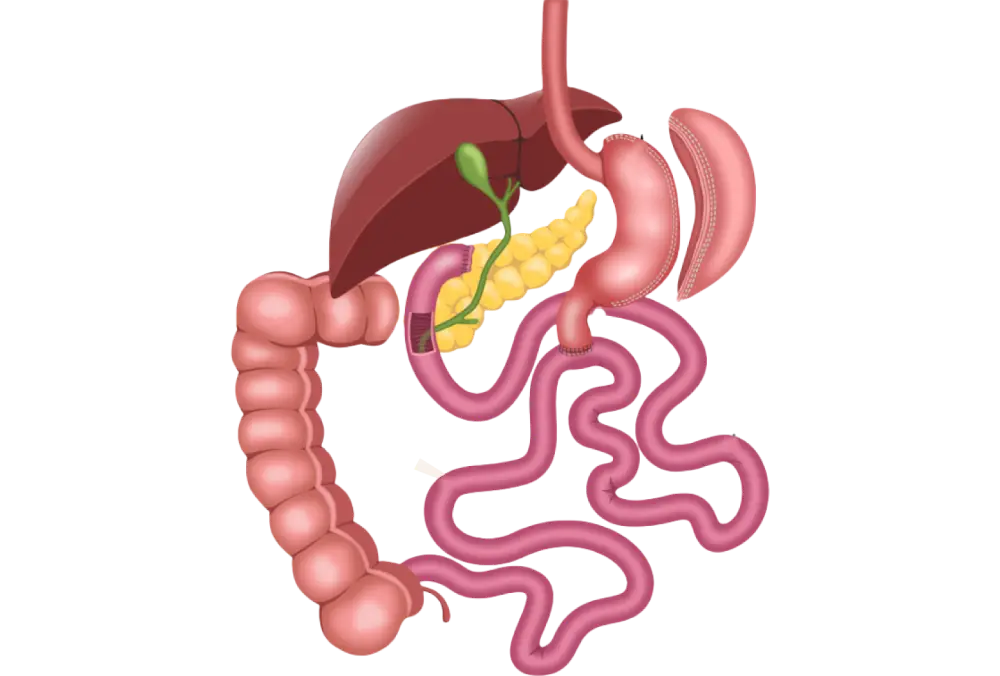Single Anastomosis Duodenal Switch
Home -> Single Anastomosis Duodenal Switch

- Laparoscopic Sleeve Gastrectomy
- Roux-en-Y Gastric Bypass Surgery
- Mini Gastric Bypass
- Endoscopic Sleeve Gastroplasty
- Single Anastomosis Duodenal Switch
- Duodenal Switch
- Revisions Surgeries
Overview
Single Anastomosis Duodenal Switch (SADS) is an advanced bariatric procedure that combines the benefits of two well-known weight-loss surgeries: the duodenal switch (DS) and the gastric sleeve. It offers significant weight loss and improvement in obesity-related health conditions. SADS is considered a more simplified version of the traditional duodenal switch with a single connection (anastomosis) between the stomach and intestine.
How Does Single Anastomosis Duodenal Switch Work?
- Gastric Sleeve:
Like the gastric sleeve procedure, a portion of the stomach is removed, reducing its size and limiting food intake. This helps in feeling full with smaller amounts of food. - Intestinal Rerouting:
The small intestine is rerouted to a single anastomosis point, bypassing a significant portion of the stomach and intestine. This limits the absorption of calories and nutrients, leading to effective weight loss. - Single Connection:
Unlike traditional duodenal switch surgery, which requires multiple connections, SADS uses a single connection between the stomach and intestine. This simplifies the procedure and reduces operative risks.
Benefits of Single Anastomosis Duodenal Switch
- Significant Weight Loss:
SADS can result in the loss of 60-80% of excess weight within the first 12–18 months. - Improvement of Health Conditions:
It can improve or resolve obesity-related conditions like type 2 diabetes, hypertension, and sleep apnea. - Simpler and Safer:
The single anastomosis reduces the complexity of the surgery and the risk of complications such as bowel obstructions, making it a safer option compared to traditional duodenal switch. - Long-Term Effectiveness:
The combination of restriction (gastric sleeve) and malabsorption (intestinal bypass) results in sustainable weight loss over time.
Who is a Good Candidate for SADS?
SADS is typically recommended for patients with:
- A BMI ≥35 or ≥40.
- Severe obesity-related health conditions.
- Failure with non-surgical weight loss methods like diet and exercise.
- A desire for a permanent solution that offers long-term weight loss.
Risks and Considerations
- Nutritional Deficiencies:
Since the procedure reduces nutrient absorption, lifelong supplementation (vitamins and minerals) is essential to avoid deficiencies. - Risk of Malnutrition:
If not monitored closely, malnutrition could occur due to the reduced absorption of calories and nutrients. - Post-Surgery Monitoring:
Regular follow-ups with healthcare providers are critical to monitor weight loss, nutrition, and overall health.
Conclusion
The Single Anastomosis Duodenal Switch (SADS) is a promising, effective weight-loss surgery for patients struggling with severe obesity. It offers substantial weight loss, improves obesity-related health conditions, and carries fewer risks than the traditional duodenal switch. However, like any bariatric surgery, it requires lifelong commitment to a healthy diet, supplements, and regular medical check-ups to ensure success and long-term health.
